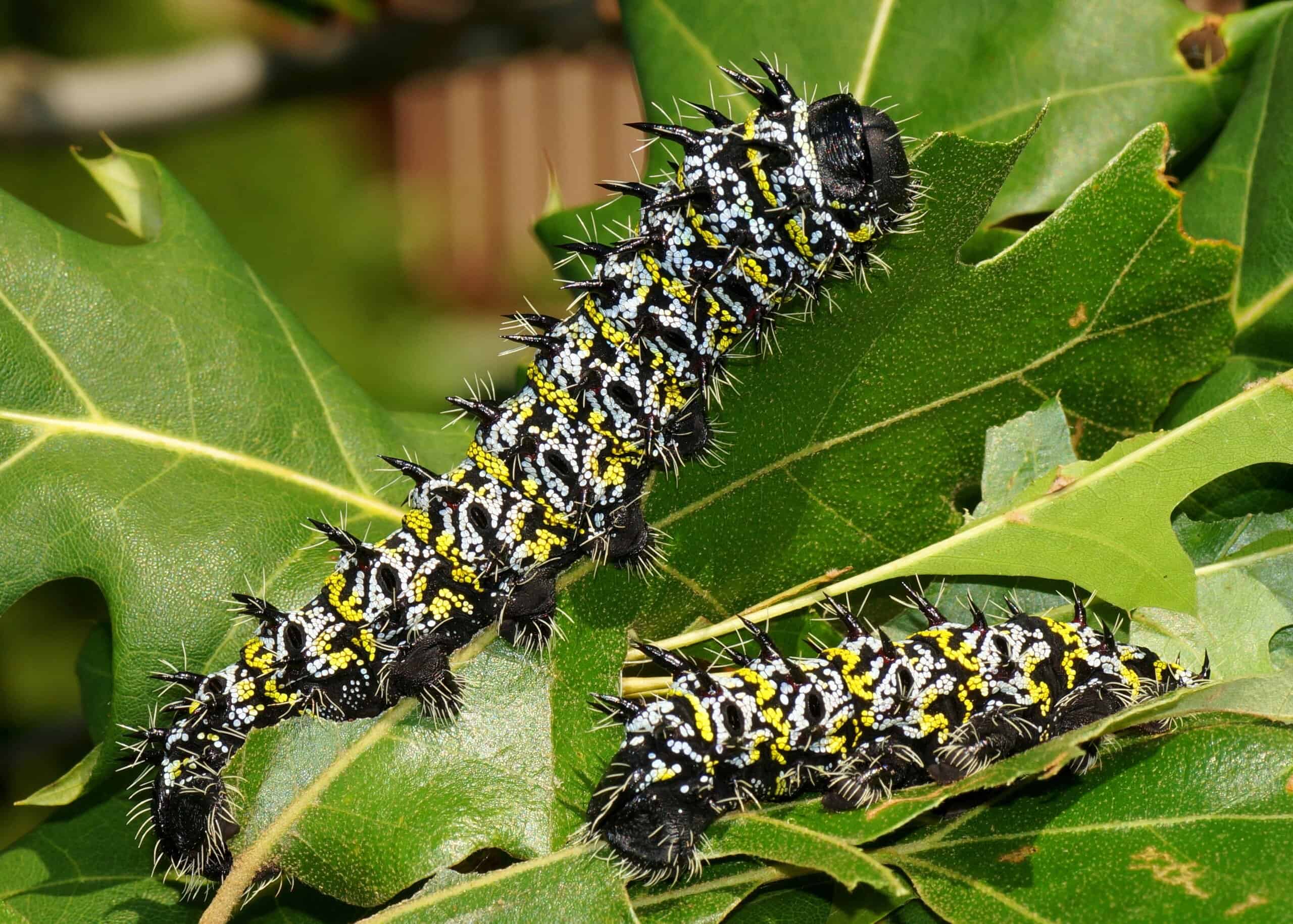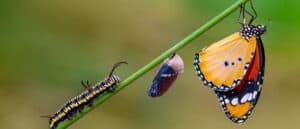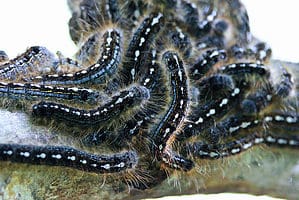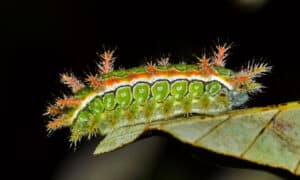Caterpillars, those curious creatures crawling through our gardens and forests, have long captivated the imagination of scientists and nature enthusiasts alike. With their intriguing shapes, vibrant colors, and astonishing transformations, these tiny creatures hold within them a secret world waiting to be discovered. Understanding caterpillars can be quite valuable to the hobbyist and gardeners alike.
At first glance, caterpillars may seem insignificant and unremarkable. But do not be deceived by their unassuming nature! These miniature marvels possess an array of adaptations and survival strategies that have evolved over millions of years. From their specialized mouthparts and clever camouflage to their extraordinary ability to regenerate lost body parts, caterpillars are the unsung heroes of the insect kingdom. In this article, we’ll learn about understanding caterpillars, from identification to habitat to garden management.
Introduction: Unveiling the Intriguing World of Caterpillars – A Vital Component of Ecosystems
Caterpillars are seemingly insignificant creatures that wriggle through our gardens and meadows. However, they play a crucial role in maintaining the balance of ecosystems. These small but mighty organisms are not only fascinating to observe but also provide essential services that contribute to the health and vitality of our natural world.
Diversity and Abundance
Caterpillars are incredibly diverse, with thousands of species inhabiting various ecosystems around the globe. They come in a multitude of shapes, sizes, and colors, each adapted to thrive in specific environments. Their sheer abundance makes them a significant presence within their respective ecosystems.
Food for Other Species
Caterpillars are a vital food source for a wide range of animals. Birds, reptiles, amphibians, and mammals, including bats, rely on caterpillars as a key component of their diet. Their high nutritional value, coupled with their availability during the warmer months, make caterpillars a critical energy source for these animals.
Pollination
While caterpillars are primarily known for their role as herbivores, some species also contribute to pollination. Certain butterfly and moth caterpillars feed on nectar-rich flowers, inadvertently transferring pollen from one flower to another as they move. This interaction promotes cross-pollination, enabling the reproduction and genetic diversity of plant species.
Seed Dispersal
Caterpillars aid in seed dispersal by consuming fruits and depositing the seeds in different locations through their feces. As they move about, caterpillars inadvertently distribute seeds, helping plants colonize new areas and contributing to the overall biodiversity of ecosystems.
Nutrient Cycling
Caterpillars play a significant role in nutrient cycling within ecosystems. As they consume plant matter, they break down complex organic compounds into simpler forms. When caterpillars defecate, these simplified nutrients are returned to the soil, enriching it with essential elements for the growth of other plants and microorganisms.
Interactions with Plants
Caterpillars and plants have a fascinating relationship. While some caterpillars are generalists and can feed on a variety of plant species, others have specialized diets, often feeding on a particular plant or plant family. This interaction can have profound effects on plant populations, influencing their growth, reproduction, and overall distribution.
Natural Pest Control
Believe it or not, caterpillars can contribute to natural pest control in agricultural settings. Some caterpillar species feed on crop-damaging insects, helping to keep their populations in check. By reducing the need for chemical pesticides, caterpillars play a crucial role in maintaining ecological balance and promoting sustainable farming practices.
Identification: Recognizing Caterpillars – A Comprehensive Guide to Species Identification
The caterpillar is the larval stage of butterflies and moths. They come in a huge range of colors, sizes, and shapes. It is very fun and quite interesting to identify these unique species. You can learn to tell one caterpillar species from another by learning the essential traits and characteristics.
Physical Qualities
A variety of physical characteristics that caterpillars display can be used to identify them. Body size, coloration, and the existence of distinguishing features or markings are a few of these. You may start to whittle down the choices and perhaps identify the kind of caterpillar you have come across by keeping an eye out for these characteristics.
Body Size and Shape
The body types of caterpillars can range from long and cylindrical to thick and chunky. Others may have bodies covered with spines or hair, while some may have smooth bodies. Pay close attention to the body’s overall dimensions as well, since they can fluctuate greatly across species and range from a few millimeters to several centimeters in length.

Color Patterns and Markings
Identification of a caterpillar can be aided by the color patterns and markings on its body. Some caterpillars have striking colors that strike the eye, while others could disguise themselves by blending in with their environment. Keep an eye out for distinctive bands, stripes, spots, or other patterns that are exclusive to a given species.
Head Capsule
The head capsule of a caterpillar can also offer valuable information for identification. The head typically has a deeper hue and may be distinguished by distinguishable patterns or features, such as horns or spines. These characteristics may be unique to specific caterpillar species and can vary in size and form.
Feeding and Behavioural Patterns
Observing a caterpillar’s behavior and feeding habits can provide additional insights for identification. While some caterpillars are more opportunistic eaters, others have a preferred host plant. Knowing a caterpillar’s favorite food source can help identify it and aid to eliminate other potential candidates.
Photographic References and Field Guides
Field guides and photographic references are useful tools for identifying caterpillars. A wide range of caterpillar species are covered in great depth in several publications, online databases, and mobile applications. Your observations can be used to identify the caterpillar you have come across by comparing them to these references.
Seek Expert Opinion
An entomologist or skilled naturalist may be needed in some situations to identify caterpillars. If you are doubtful or come across a species that is particularly difficult to identify, think about getting in touch with local experts or groups that specialize in researching insects and caterpillars. They can help identify the caterpillar in question by providing direction and support.
Diet: The Caterpillar’s Menu – Understanding Caterpillars and Their Feeding Habits
Caterpillars have a wide variety of nutritional preferences and a ferocious appetite. To grasp their function in ecosystems and their influence on plant populations, it is important to understand their diet and feeding behaviors.
Generalist and Specialist Feeders
Based on their preferred foods, caterpillars can be categorized as either generalists or specialist eaters. Specialist feeders are more selective and depend on a limited number of host plants, whereas generalist feeders have a wider diet and may eat a range of plants.
Host Plants
Host plants are the plants on which caterpillars lay their eggs and feed during their larval stage. Different caterpillar species have different preferences for their host plants, which might include everything from grasses, trees, and shrubs to herbaceous plants. Some caterpillars are extremely specialized and only eat one type of plant.
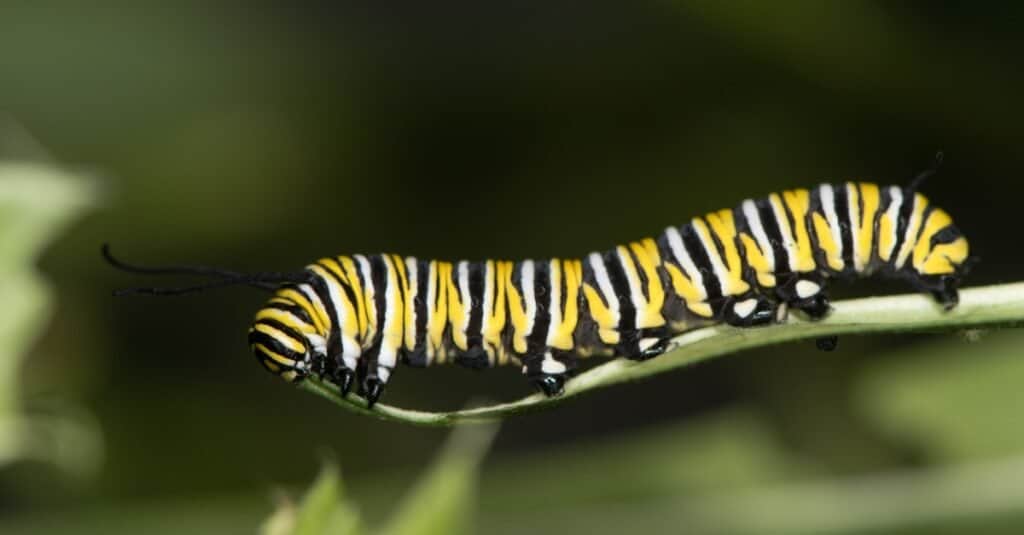
Caterpillars like the
monarch butterfly
caterpillar have very specific host plant needs. For this caterpillar, the host plant is milkweed.
©iStock.com/Ian_Redding
Feeding Methods
Different feeding techniques are used by caterpillars based on their species and source of food. They may eat flowers, leaves, and stems with their chewing mouthparts. Some caterpillars use silk to build webs or shelters to keep themselves safe while they eat, while others may eat in the open.
Herbivorous Diet
Caterpillars are mostly herbivores that only consume plant matter. Their host plants provide them with vital compounds, energy, and nourishment. Caterpillars are essential in controlling plant populations and affecting the dynamics of plant communities because they consume plant tissues.
Defensive Adaptations
Different defensive mechanisms have developed in caterpillars to help them stay safe while eating. Some caterpillars include defense mechanisms against possible predators, such as spines, hairs, or stinging features. Just as well, these defenses can lessen resource competition and help caterpillars tolerate environmental obstacles.
Chemical Interactions
Caterpillars and their host plants can interact chemically. They could create chemicals that attract predators of prospective herbivores or that assist in discouraging herbivores. In response, plants may emit chemical signals that draw particular kinds of caterpillars or elicit defensive reactions.
Impact on Plant Populations
Caterpillars can significantly impact the populations and communities of plants. Caterpillars feeding on leaves can defoliate plants, which can hinder their ability to develop and reproduce. This herbivory may have an impact on ecosystem structure, population dynamics, and plant fitness.
Ecological Balance
Caterpillars contribute to the ecological balance despite the possibility that they might harm plants. They are an essential component of food webs, providing food for a variety of predators, such as birds, reptiles, and mammals. Plant reproduction and biodiversity are also influenced by caterpillar interactions with plants, such as pollination and seed distribution.
Habitat: Home for Caterpillars – Understanding Caterpillars and Their Natural and Urban Habitats
Caterpillars inhabit a wide range of habitats, including natural environments and urban landscapes.
Natural Habitats
The majority of the time, natural settings including woods, meadows, grasslands, wetlands, and even deserts are home to caterpillars. Caterpillars are dependent on a wide variety of host plants and other natural resources found in these settings to survive. Caterpillars may find a wide variety of food sources and hiding places in natural settings because of the lush tapestry of plants present.

Natural habitats provide plenty of safe spaces for caterpillars to undergo their metamorphosis into butterflies.
©Bryan St Croix/Shutterstock.com
Diverse Vegetation
Caterpillars rely on a wide variety of plant species found in natural environments for food. Every species of caterpillar has a preferred host plant, and the prevalence and availability of these plants in their native environments is a factor in the success and longevity of caterpillar populations. The variety of vegetation also supports a greater diversity of caterpillar species.
Complex Ecosystem Interactions
In their native surroundings, caterpillars participate in intricate ecological interactions. As a vital source of food for a range of predators, such as birds, reptiles, amphibians, and mammals, they play significant roles in food webs. Caterpillars also aid in activities like pollination and seed dissemination, which have an impact on the diversity and health of plant populations.
Urban Habitats
Caterpillars have also adapted to urban environments, where human activities have transformed the landscape. Urban habitats include parks, gardens, green spaces, and even roadside vegetation in cities and towns. While urban environments may present challenges, caterpillars have demonstrated remarkable adaptability.
Urban Vegetation
Despite the presence of buildings and infrastructure, urban habitats often contain pockets of vegetation that caterpillars can utilize. Parks and gardens provide a diverse range of ornamental and native plants, acting as potential host plants for caterpillars. Urban areas with a variety of flowering plants can support butterfly species that have caterpillars feeding on nectar-rich flowers.
Artificial Structures and Microhabitats
Caterpillars in urban habitats may exploit artificial structures and microhabitats. These can include cracks in pavements, walls, and fences, where certain plant species may grow. Some species may also find suitable host plants on balconies or rooftops with container gardens. Caterpillars may utilize these smaller-scale habitats within the urban landscape.
Challenges and Opportunities
Urban habitats pose challenges for caterpillars due to pollution, habitat fragmentation, and limited availability of suitable plants. However, urban environments can also present unique opportunities. Reduced predation pressure, a more constant food supply, and altered microclimates can favor certain caterpillar species.
Garden Management: Achieving a Balance – Strategies for Cultivating or Controlling Caterpillars in Your Garden
Caterpillars, while fascinating creatures, can sometimes pose challenges for home gardeners. Balancing the desire to appreciate their presence with the need to protect plants requires implementing effective strategies for cultivating or controlling caterpillar populations.
Encouraging Beneficial Insects
Attracting beneficial insects to your garden can help control caterpillar populations naturally. Predatory insects like ladybugs, lacewings, and parasitic wasps feed on caterpillars and their eggs. To encourage these beneficial insects, plant a diverse range of flowering plants that provide nectar and pollen throughout the growing season. Avoid using broad-spectrum insecticides that may harm both harmful and beneficial insects.
Handpicking
For smaller gardens or when caterpillar populations are limited, handpicking can be an effective method of control. Regularly inspect plants and manually remove caterpillars by hand, placing them in a bucket of soapy water. This approach allows for targeted removal while minimizing harm to other garden inhabitants.
Barriers and Physical Exclusion
Using physical barriers can protect vulnerable plants from caterpillar damage. Lightweight garden fabric, netting, or mesh can be draped over plants to prevent adult butterflies from laying eggs on the leaves. This method is particularly useful for high-value plants or specific areas of the garden where protection is desired.
Companion Planting
Strategic companion planting can help deter caterpillars from feeding on susceptible plants. Some plants, such as marigolds, garlic, and onions, emit natural compounds that repel insects. Interplanting these companion plants with vulnerable species can act as a deterrent and reduce caterpillar damage.
Selective Pruning
Pruning affected plant parts can help manage caterpillar populations while promoting plant health. Inspect plants regularly and remove heavily infested or damaged leaves, stems, or branches. This practice not only reduces caterpillar numbers but also helps improve airflow and sunlight penetration, preventing further infestation.
Tolerating Some Damage
In a garden setting, it is important to consider the ecological balance and the role caterpillars play in supporting biodiversity. Depending on the severity of the infestation and the specific plant species, it may be acceptable to tolerate some caterpillar damage. A few nibbled leaves can be a sign of a healthy ecosystem, providing food for other organisms and supporting the natural lifecycle of butterflies and moths.
When it comes down to it, understanding caterpillars is important as a gardener. They are not a bad thing to have in your garden. And if their populations start munching on more of your plants than you’re comfortable with, there are many holistic ways to reduce their numbers. Plus, it’s just plain fun to be able to identify them. Happy planting!
Thank you for reading! Have some feedback for us? Contact the AZ Animals editorial team.

